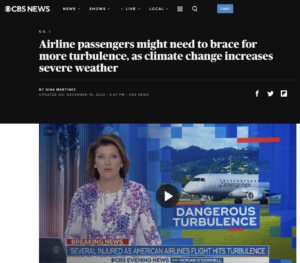BY GINA MARTINEZ
Why airline passengers might see more frequent turbulence
Turbulence, which causes planes to suddenly jolt while in flight, is considered a fairly normal occurrence and nothing to fear. …
Air turbulence induced injuries in the US are up about 0.5% since 2002. Passenger numbers have increased over 32% in same period. IOW, turbulence related injuries per passenger is not increasing. Its DECREASING.https://t.co/JCZEkeGihbhttps://t.co/p6FV93JGDt"
— Les Johnson (@LesJohnsonHrvat) December 24, 2022
2016 Paper: ‘Global warming’ causing airline turbulence
UK Guardian: “It is predicted there will be more and more incidents of severe clear-air turbulence, which typically comes out of the blue with no warning, occurring in the near future as climate change takes its effect in the stratosphere,” Dr Paul Williams, a Royal Society research fellow at Reading University, said last week.
“And as carbon dioxide levels in the atmosphere keep on rising, so will the numbers of incidents.”
Flashback 2014: NBC News: Fasten Seat Belts: Climate Change Could Mean More Airline Turbulence – ‘Computer models have predicted that climate change and increased carbon dioxide levels will speed up the jet stream, leading to more serious episodes by 2050.’





